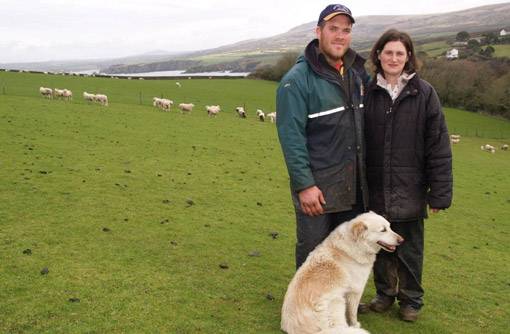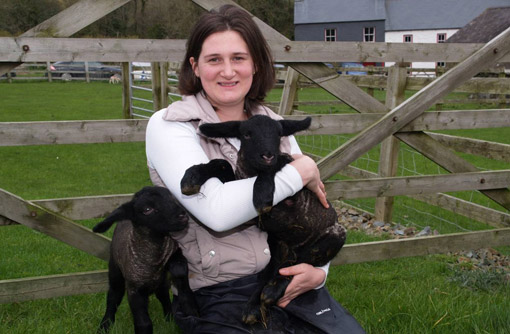Attention to detail pays off at Dinas Island Farm

Further evolution of the low-input sheep system at our Welsh Management Matters farm has yielded good results this spring. Debbie James reports
Paying attention to the flock trace element balance has paid off at Dinas Island Farm where ewe empty rates have been halved.
With just 29 empty ewes in the flock of 1,530 Lleyn and commercial ewes, Neil Perkins cites bolusing the ewes pre-tupping as the likely reason. The twice-a-year treatment with Tracesure, pre-tupping and at housing, costs £1.30 a head, but he is delighted with the results. “It means we don’t have to carry unproductive ewes for a year and it keeps our replacement rates down.”
Neil also credits the rams he sourced from Worcester breeder Marcus Bullock. “They tupped 130 ewes per head, with the bulk of these lambing over a three-week period, which is impressive when our average ram-ewe rate used to be between one ram and 50 ewes lambing over a six-week period.”
The Lleyns scanned at 182% with the whole flock averaging 175%. There were fewer triplets this year but more twins. “We never aim to scan higher than 180%. We avoid flushing to manage lambing percentages. Lleyns can be prone to triplets if they are not carefully managed,” Neil says.
Early start to lambing
Lambing was due to get under way on 1 March but the first lambs started arriving on 25 February and 1,000 ewes had lambed by 11 March. Teasers were run with the ewes prior to tupping, which got ewes cycling faster and led to a more compact lambing period, Neil says.
But he admits the short, intense lambing period did stretch the labour force to the limit. “When the lambs started arriving a week early it did catch us out. We were still setting up lambing pens when the first batches were lambing. It was a week after we had our first lambs before we had everything set up.”

The lambing team to support Neil and his father Roger this year included Neil’s wife Lynda, brother Phil and family friend Linda. Additional labour was also drafted in with Yorkshireman Tom Rayner returning for his third lambing season and Gelli Aur College agricultural student, Josh Burr, on a work experience placement.
“I am on call 24 hours a day in the lambing shed catching sleep when possible in a bed set up in the office which is part of the building. At the peak, shifts averaged 17 hours but with the tight lambing period it was over fast enough. Fortunately the weather was on our side, which was a massive benefit,” Neil says.
Managing lambs
All the Lleyns lambed indoors but the throughput was so fast most of the ewes and lambs were turned out to grass within 48 hours. The lambing shed incorporated 150 individual pens for the ewes to “mother-up” in. Once the lambs had been ringed, tagged, weighed and recorded they were moved into group pens with six ewes to get them used to being with others before being turned out. The low-cost system at Dinas Island Farm relies on rested grass to provide a fresh bite for spring turnout.
Neil has a system of colour coding for ease of management. Ewes and lambs turned out into each field are numbered in a different colour with a set number of ewes in each field. “It is easier to check for strays when we are going around the fields checking the groups,” says Roger.
Ten days after the Lleyns lambed the first of the commercial flock started to produce. Last to lamb were 350 ewe lambs outside at nearby Hendre Farm. The fields there are much smaller so the flock can be run as small groups.
Cold snap losses
Unusually warm weather (25C) at the start of lambing gave perfect conditions for lambing outdoors, but midway through the temperature plummeted to below freezing with rain and biting wind, says Roger. It was such a dramatic turnaround that unfortunately we did suffer a few losses.
“The grass turned black because we are in a coastal location and had salt blowing in from the sea. We will have lost some spring grass growth too.”
Managing feed
The ewes were in good condition ahead of lambing because they had been wintered on good tack ground before being housed. Care had to be taken with their management to prevent over-fattening. After the tups were removed, the ewes were held on restricted grass to manage body condition.
Foot health was the best it had ever been. “We had no building projects on the go as we have had in previous years so we had time to footbath the ewes and I think the boluses helped too,” says Neil.
The ewes were housed eight weeks before lambing to ensure there would be adequate grass for turnout. The flock was fed hay until six weeks prior to lambing. After that period the triplet-bearing ewes continued to be fed hay while the remainder were given a finely chopped mix of silage bales averaging 40% dry matter, 14% protein and 12% ME. This was fed on its own until four weeks before lambing when a supplement of an 18% ewe nut was introduced at a rate of 350g to the twin-bearing ewes and 100g to the singles. The ewes carrying triplets were fed the same concentrates at a rate of 500g, twice a day from six weeks prior to lambing.
The lambs will be sold at 17-19kg, starting in mid-June.
Heifer rearing pleases
Just as lambing got under way, the first of the contract rearing spring-born calves arrived and last year’s batch of 200 12-month-old heifers were returned to their owner.
Neil was delighted with the growth rates, with the group averaging 0.72kg a head per day, equating to an average weight of 294kg at 12 months. Winter growth was also good at 1kg a head per day with the best heifer achieving 1.4kg per day, returning at 403kg at 12 months. The autumn-born heifers left the farm in April, also with average growth weights of 0.72kg a head per day, giving an average weight of 185kg at approximately seven months old.
The Perkins’ heifer rearing enterprise has been expanding each year with numbers peaking at 300. When the enterprise started with 60 heifers in 2008, the stock stayed on the farm until they were 18 months old. As the system expanded this was reduced to 12 months.
“When we started contract rearing we were advised that as the sheep system was low cost we had to manage the cattle numbers to suit the grass and keep the excess for the sheep,” says Neil.
“We were never over-stocked but it didn’t feel comfortable having so much stock on the farm. We didn’t want to overdo the grazing and would rather have a surplus of grass on the farm than a shortage. In September last year we had 300 cattle on the farm and could see the grass disappearing. To maintain this we would have had to spend a lot of money on fertiliser and making silage which does not suit the system.”
To relieve pressure on the winter pastures, tack grazing was found for some of the flock with 150 acres rented pre-housing.
In future 100 autumn-born heifers will leave a month after weaning and the 200 spring batch will be split in to two batches, with some leaving at three months and the remainder at 12 months, at the beginning of April.
Computerised calf rearing
The calves arrive on the farm as seven-day-olds, when they are weighed and put into rearing pens of 25. A computerised calf rearing machine, which is programmed to collars fitted to the calves, calculates how much milk each needs. The ration builds from four litres to six litres a day over a minimum of four visits and the calves are also offered free-access pellets.
It was the calf rearing together with all the other activities that kept Dinas Island Farm of considerable interest to Neil’s grandfather, Peter, throughout his retirement. Sadly he died in March, but the family say his vision lives on in the business. They still farm under his name as Peter J. Perkins and Co Ltd, the company he established in 1947.
Tourism boost
Another of the farm’s enterprises – the holiday cottages and campsite – attracted good visitor numbers at Easter. A circular footpath surrounds Dinas Island Farm and attracts visitors to the farm. All four cottages were booked for the two-week holiday period.
“We get bookings through a holiday cottage company and we have our regulars that come back,” says Roger, who runs the cottages with Neil’s wife, Lynda. “These days a lot of our bookings tend to be last minute. You have to hold your nerve because there can be big gaps in the booking schedule but you hope that they will always fill up in the end.”
After three summers of dull weather he is hoping for improved conditions this year. “We need a good summer to restore confidence in the Pembrokeshire weather.”
Good weather would also be a bonus when Dinas Island Farm hosts one of the British Grassland Society’s summer tour visits in July. With 150 visitors expected, the Perkins’ are prepared to be scrutinised. “We know we will learn a lot from it and the questioning will make us think about what we are doing,” says Roger.
